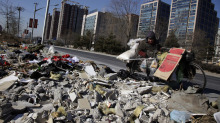China faces growing garbage problem
 The Beijing suburb of Tongzhou has had to learn how to live with rubbish. In one neighbourhood that was once surrounded by fields, a giant landfill covered by tarpaulin rises like a green mountain amid apartment buildings and factories.
The Beijing suburb of Tongzhou has had to learn how to live with rubbish. In one neighbourhood that was once surrounded by fields, a giant landfill covered by tarpaulin rises like a green mountain amid apartment buildings and factories.“All the trash from Beijing comes here every day,” explains a middle-aged shopkeeper whose store is a stone’s throw from the landfill. “How can it not smell bad sometimes?”
Dealing with the waste – the byproduct of a growing middle class and annual double-digit economic growth over the past 10 years – is one of the biggest problems facing China’s urban planners.
While most of the trash, which ranges from food waste to construction debris and plastic packaging, is placed in landfills, policy makers are shifting toward incineration as volumes increase, despite some protests from residents and environmental groups.
Beijing’s urban expansion has brought the trash problem close to home. Landfill areas once on the city’s outskirts where many of the city’s migrant workers live now sit in the middle of the urban sprawl that has grown up around them.
While China produces far less rubbish on a per-capita basis than countries like the United States, its total production, at more than 300 million tonnes annually, according to academic studies, is the largest in the world – and growing.
Beijing’s 20 million people produce 23,000 tonnes of waste each day, equivalent to the weight of nine filled Olympic-size swimming pools. Thanks to rising incomes and higher standards of living, China generates trash at a rate that has risen twice as fast as its population growth over the past several decades.
Even in the best-managed cities like Beijing, the government has struggled to keep up with the increasing volumes of waste. From 2005 to 2010, the capital collected an average of 3,900 tonnes of trash a day beyond what it had the capacity to treat, according to government statistics.
Beijing is not alone. Cities like New York and London have also had to wrestle with the challenges of urban waste and find themselves running out of options as landfills overflow and new incinerators prompt environmental protests.
In the capital, forgotten corners of places like Tonghzou were for years the site of illegal dumps that some dubbed the “seventh ring road” of the city, a reference to the giant highways that ring Beijing. These dumps eventually sparked a media outcry and in 2010 the government began a 10 billion yuan ($1.6-billion) cleanup campaign that targets illegal landfills and builds new facilities.
“There used to be a huge dump there, but they came and took all the trash away,” says a driver on the roadside in a rural area of Tongzhou, as he gestures toward a field down the road. Now the field is littered with plastic bags and some construction debris, but no dump is visible.
While Beijing may have cleaned up many of its dumps, China’s waste problem is most acute in the countryside, according to Xu Haiyun, chief engineer at the China Urban Construction Design Institute.
“Outside of the cities, there are vast areas that still have no collection system,” Mr. Xu said. “The environmental problems caused by trash will only get more serious with time.”
Big cities are increasingly favouring incineration as a way to deal with the rubbish, and China is expected to build about 90 new plants over the next three years that will generate energy by burning waste.
Cities are also splashing out on technology that will make landfills more economic, like burning landfill gases to generate electricity that can be sold back to power grids. Beijing, which burned just 10 per cent of its trash in 2010 and plans to raise that to 40 per cent by 2015, is building Asia’s largest incinerator.
Waste management companies say that China’s enthusiasm for incineration stands in sharp contrast to the United States, where approval for new plants is hard to get.
“From a policy point of view, China is great,” said Sanjiv Khattri, chief financial officer for Covanta Energy, a global company that partly owns four waste-to-energy plants in China. “They have targets for renewable energy, for how much waste to energy they want to develop and you get subsidies for waste-to-energy plants.”
Academics warn that the best long-term solution is reducing the amount of trash that cities produce.
“To deal with the municipal waste issue, you have to think of trash reduction, recycling and management, everything from start to finish,” says Nie Yongfeng, a retired professor and waste expert at Tsinghua University. “You can’t solve the problem by focusing only on trash disposal.”
But for the residents of Tongzhou, some respite is in sight. “I think it’s almost full,” says the shopkeeper as huge trash trucks roar by the front of her store to deliver their evening load.
You can return to the main Market News page, or press the Back button on your browser.

